Starch and Dough-Related Properties of Wheat (Triticum aestivum L.) Exposed to Varying Temperatures and Radiances after Anthesis
Abstract
1. Introduction
2. Materials and Methods
2.1. Experimental Site and Design
2.2. Measurement Items
2.2.1. Calculation of Post-Anthesis Temperature
2.2.2. Calculation of Post Anthesis Radiation
2.2.3. Determination of Starch Content
2.2.4. Determination of Falling Number
2.2.5. Determination of Starch Gelatinization
2.2.6. Determination of Dough Properties
2.3. Experimental Data Collection and Analysis
3. Results
3.1. Effects of Different Sowing Dates on Post-Anthesis Temperature and Radiation of Wheat
3.2. Effects of Different Treatments on the Starch Content and Falling Number of Wheats
3.3. Effects of Different Treatments on the Pasting Properties of Wheat Starch
3.4. Effects of Different Treatments on Wheat Dough Properties
3.5. Correlation of Different Temperature and Radiation on starCH and Falling Value of Wheat
3.6. Correlation between Different Temperature and Radiation on Wheat Dough Properties
4. Discussion
4.1. Changes in Temperature and Radiation after Anthesis at Different Sowing Dates
4.2. Study on Wheat Starch at Different Temperatures and Radiations
4.3. Study of the Properties of Wheat Dough under Different Temperature and Radiation
5. Conclusions
Author Contributions
Funding
Data Availability Statement
Acknowledgments
Conflicts of Interest
References
- Ma, J.; Xiao, Y.; Hou, L.; He, Y. Combining Protein Content and Grain Yield by Genetic Dissection in Bread Wheat under Low-Input Management. Foods 2021, 10, 1058. [Google Scholar] [CrossRef]
- Hawkins, E.; Chen, J.; Watson-Lazowski, A.; Ahn-Jarvis, J.; Barclay, J.E.; Fahy, B.; Hartley, M.; Warren, F.J.; Seung, D. STARCH SYNTHASE 4 is required for normal starch granule initiation in amyloplasts of wheat endosperm. New Phytol. 2021, 230, 2371–2386. [Google Scholar] [CrossRef]
- Dankwa, K.O.; Liu, Y.J.; Pu, Z.E. Evaluating the nutritional and sensory quality of bread, cookies and noodles made from wheat supplemented with root tuber flour. Br. Food J. 2017, 4, 895–908. [Google Scholar] [CrossRef]
- Zhang, R.; Ma, S.; Li, L.; Zhang, M.; Tian, S.; Wang, D. Comprehensive utilization of corn starch processing by-products: A review. Grain Oil Sci. Technol. 2021, 4, 89–107. [Google Scholar] [CrossRef]
- Lionetto, F.; Maffezzoli, A.; Ottenhof, M.A.; Farhat, I.A.; Mitchell, J.R. Ultrasonic investigation of wheat starch retrogradation. J. Food Eng. 2006, 75, 258–266. [Google Scholar] [CrossRef]
- Chipón, J.; Ramírez, K.; Morales, J.; Díaz-Calderón, P. Rheological and Thermal Study about the Gelatinization of Different Starches (Potato, Wheat and Waxy) in Blend with Cellulose Nanocrystals. Polymers 2022, 14, 1560. [Google Scholar] [CrossRef] [PubMed]
- Crosbie, G.B. The relationship between starch swelling properties, paste viscosity and boiled noodle quality in wheat flours. J. Cereal Sci. 1991, 13, 145–150. [Google Scholar] [CrossRef]
- Liu, R.; Wei, Y.M.; Xing, Y.N.; Zhang, B.; Zhang, Y.Q. Review on the relationship between starch and noodle quality in wheat. J. Triticeae Crops 2013, 33, 1058–1063. [Google Scholar]
- Noda, T.; Tohnooka, T.; Taya, S.; Suda, I. Relationship between physicochemical properties of starches and white salted noodle quality in japanese wheat flours. Cereal Chem. 2001, 78, 395–399. [Google Scholar] [CrossRef]
- Vignola, M.B.; Baroni, V.; Pérez, G.T. Genotypic and environmental effects on starch properties of Argentinean wheat flours. Starch—Stärke 2016, 68, 1065–1072. [Google Scholar] [CrossRef]
- Parmesan, C.; Yohe, G. A globally coherent fingerprint of climate change impacts across natural systems. Nature 2003, 421, 37–42. [Google Scholar] [CrossRef]
- Ren, G.Y.; Guo, J.; Xu, M.Z.; Chu, Z.Y.; Liu, X.N. Climate changes of mainland china over the past half century. J. Meteorol. Res. 2005, 63, 942–956. [Google Scholar]
- Jun, K. Climate Change and Drought in Jiangsu Province. Ph.D. Thesis, Nanjing University of Information Science and Technology, Nanjing, China, 2008. [Google Scholar]
- Spiertz, J. The influence of temperature and light intensity on grain growth in relation to the carbohydrate and nitrogen economy of the wheat plant. Neth. J. Agric. Sci. 1977, 25, 182–197. [Google Scholar] [CrossRef]
- Liu, P.; Guo, W.; Jiang, Z.; Pu, H.; Little, C.R. Effects of high temperature after anthesis on starch granules in grains of wheat (Triticum aestivum L.). J. Agric. Sci. 2011, 149, 159–169. [Google Scholar] [CrossRef]
- Kim, K.H.; Kim, J.Y. Understanding Wheat Starch Metabolism in Properties, Environmental Stress Condition, and Molecular Approaches for Value-Added Utilization. Plants 2021, 10, 2282. [Google Scholar] [CrossRef] [PubMed]
- Zahedi, M.; Sharma, R.; Jenner, C.F. Effects of high temperature on grain growth and on the metabolites and enzymes in the starch-synthesis pathway in the grains of two wheat cultivars differing in their responses to temperature. Funct. Plant Biol. 2003, 30, 291–300. [Google Scholar] [CrossRef] [PubMed]
- Zhang, W.; Zhao, Y.; Li, L.; Xu, X.; Huang, Z. The effects of short-term exposure to low temperatures during the booting stage on starch synthesis and yields in wheat grain. Front. Plant Sci. 2021, 12, 684784. [Google Scholar] [CrossRef] [PubMed]
- Liu, Y.Y.; Zhang, H.C.; Jiang, D.; Dai, Q.G.; Huo, Z.Y.; Ke, X.U. The influence of sowing date on different gluten wheat starch viscosity characteristics. Acta Agric. Boreali-Sin. 2009, 24, 5. [Google Scholar]
- Katyal, M.; Singh, N.; Kaur, S. Physicochemical, thermal, and pasting properties of starch separated from various timely sown and delayed sown (heat stressed) wheat of different wheat lines/variety. Starch 2022, 74, 5–6. [Google Scholar] [CrossRef]
- Bo, C.; Fang, C.; Sheng, D.L.; Ai, F.L.; Dun, G.C.; Li, S.Z. Effects of High Temperature Stress During Grain-filling Stages on Protein Components and Dough Mixing Properties in Different Wheat Cultivars. J. Nucl. Agric. Sci. 2020, 34, 642–649. [Google Scholar]
- Li, W.; Yan, S.; Yin, Y.; Wang, Z. Starch granule size distribution in wheat grain in relation to shading after anthesis. J. Agric. Sci. 2010, 148, 183–189. [Google Scholar] [CrossRef]
- Hua, S.L.; Hui, S.; Li, P.Z.; Chang, P.Z.; Bin, S.P.; Qing, S. Effects of Temperature and Illumination Time on Grain Paste Property in Different Wheat Cultivars. J. Chin. Cereals Oils Assoc. 2012, 27, 5. [Google Scholar]
- He, Q.H.; Xie, Y. Study on Climatological calculation method of Total Solar radiation in China. J. Nat. Resour. 2010, 25, 308–319. [Google Scholar]
- Jin, Y.H.; Zhang, K.L.; Zhang, X.C.; Du, J.X. Determination of amylose and amylopectin in wheat and wheat malt by dual wavelength method. Chin. J. Cereals Oils 2009, 24, 137–140. [Google Scholar]
- Demotes-Mainard, S.; Jeuffroy, M.H. Incorporating Radiation and Nitrogen Nutrition into a Model of Kernel Number in Wheat. Crop Sci. 2001, 41, 415–423. [Google Scholar] [CrossRef]
- Zhang, Z.; Zhou, N.; Xing, Z.; Liu, B.; Tian, J.; Wei, H.; Gao, H.; Zhang, H. Effects of Temperature and Radiation on Yield of Spring Wheat at Different Latitudes. Agriculture 2022, 12, 627. [Google Scholar] [CrossRef]
- Li, X.D.; Zhang, D.Q.; Wang, H.F.; Shao, Y.H.; Fang, B.T.; Yue, J.Q.; Ma, F.J. Impact of temperature increment before the over-wintering period on growth and development and grain yield of winter wheat. Chin. J. Appl. Ecol. 2015, 26, 839. [Google Scholar]
- Xing, Z.P.; Pei, W.U.; Zhu, M.; Qian, H.J.; Hu, Y.J.; Guo, B.W.; Wei, H.Y.; Xu, K.; Huo, Z.Y.; Dai, Q.G. Temperature and solar radiation utilization of rice for yield formation with different mechanized planting methods in the lower reaches of the Yangtze River, China. J. Integr. Agric. 2017, 16, 1923–1935. [Google Scholar] [CrossRef]
- Yang, H.B.; Xu, C.Z.; Li, C.G. Growth and Required Accumulated Temperature of Winter Wheat under Different Sowing Time. Chin. J. Agrometeorol. 2009, 30, 201–203. [Google Scholar]
- Porter, J.R.; Gawith, M. Temperatures and the growth and development of wheat: A review. Eur. J. Agron. 1999, 10, 23–36. [Google Scholar] [CrossRef]
- Kohyama, K.; Sasaki, T.; Yasui, T.; Matsuki, J. Effects of environmental temperature on structure and gelatinization properties of wheat starch. Cereal Chem. 2003, 80, 476–480. [Google Scholar]
- Yong, Z.; Hui, H.Y.; Li, P.R.; Rong, Z.; Yu, R.D.; Xu, R.Y.; Fei, X. Physicochemical Properties of Wheat Starch under Different Sowing Dates. Starch—Stärke 2022, 74, 2100290. [Google Scholar] [CrossRef]
- Li, C.Y.; Zhang, R.Q.; Fu, K.Y.; Li, C.; Li, C. Effects of high temperature on starch morphology and the expression of genes related to starch biosynthesis and degradation. J. Cereal Sci. 2017, 73, 25–32. [Google Scholar] [CrossRef]
- Lu, H.; Hu, Y.; Wang, C.; Liu, W.; Ma, D. Effects of high temperature and drought stress on the expression of gene encoding enzymes and the activity of key enzymes involved in starch biosynthesis in wheat grains. Front. Plant Sci. 2019, 10, 1414. [Google Scholar] [CrossRef]
- Singh, S.; Gupta, A.K.; Gupta, S.K.; Kaur, N. Effect of sowing time on protein quality and starch pasting characteristics in wheat (Triticum aestivum L.) genotypes grown under irrigated and rain-fed conditions. Food Chem. 2010, 122, 559–565. [Google Scholar] [CrossRef]
- Hu, Y.; Xue, J.; Li, L.; Cong, S.; Yu, E.; Xu, K.; Zhang, H. Influence of dynamic high temperature during grain filling on starch fine structure and functional properties of semi-waxy japonica rice. J. Cereal Sci. 2021, 101, 103319. [Google Scholar] [CrossRef]
- Liu, X.; Cai, R.; Li, Y.; Zhang, M.; Yang, M.; Zhang, Y. Starch component characteristics and physicochemical properties in wheat grains with different amylose contents in relation to low light after anthesis. Starch–Stärke 2018, 70, 1700050. [Google Scholar] [CrossRef]
- Deng, N.; Ling, X.; Sun, Y.; Zhang, C.; Fahad, S.; Peng, S.; Cui, K.; Nie, L.; Huang, J. Influence of temperature and solar radiation on grain yield and quality in irrigated rice system. Eur. J. Agron. 2015, 64, 37–46. [Google Scholar] [CrossRef]
- Bonfil, D.J.; Abbo, S.; Svoray, T. Sowing date and wheat quality as determined by gluten index. Crop Sci. 2015, 55, 2294–2306. [Google Scholar] [CrossRef]
- Fan, J.; Zhang, B.; Lv, G.; Gao, D.; Wu, L.; Lu, C.; Wu, H.; Zhang, Y.; Cheng, S. Effects of sowing date on main quality characters and flour mass parameters of wheat. Jiangsu Agric. Sci. 2003, 31, l0–l12. [Google Scholar]
- Yao, Y.; Wang, X.; Chen, J.; Yan, H.; Mu, Q.; Liu, P.; Tian, X. Bidirectional effect of warming during filling on grain setting and quality of wheat and its relationship with nitrogen application rate. J. Triticeae Crops 2015, 35, 860–866. [Google Scholar]
- Williams, R.M.; Diepeveen, D.A. Evaluating the impact of rainfall and temperature on wheat dough strength in western Australia. Cereal Chem. 2019, 96, 370–379. [Google Scholar] [CrossRef]
- Stone, P.J.; Savin, R.; Wardlaw, I.F.; Nicolas, M.E. The influence of recovery temperature on the effects of a brief heat shock on wheat. i. grain growth. Funct. Plant Biol. 1995, 22, 945–954. [Google Scholar] [CrossRef]
- Turksoy, S.; Erturk, M.Y.; Kokini, J. Behavior of semolina, hard, soft wheat flour dough at different aging times and temperatures through laos properties and molecular interactions of proteins. J. Food Eng. 2021, 301, 110549. [Google Scholar] [CrossRef]
- Blumenthal, C.S.; Barlow, E.W.R.; Wrigley, C.W. Growth environment and wheat quality: The effect of heat stress on dough properties and gluten proteins. J. Cereal Sci. 1993, 18, 3–21. [Google Scholar] [CrossRef]
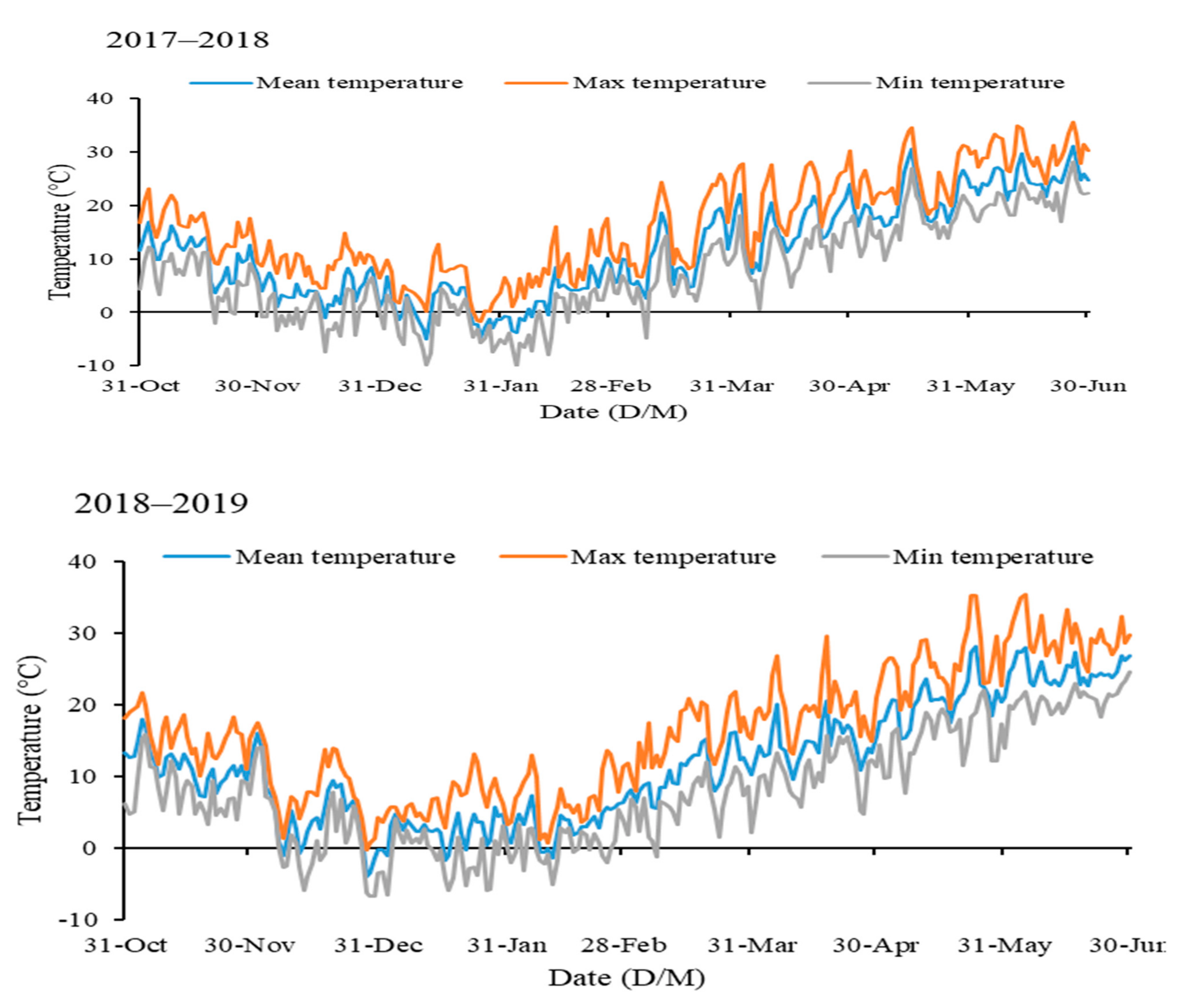


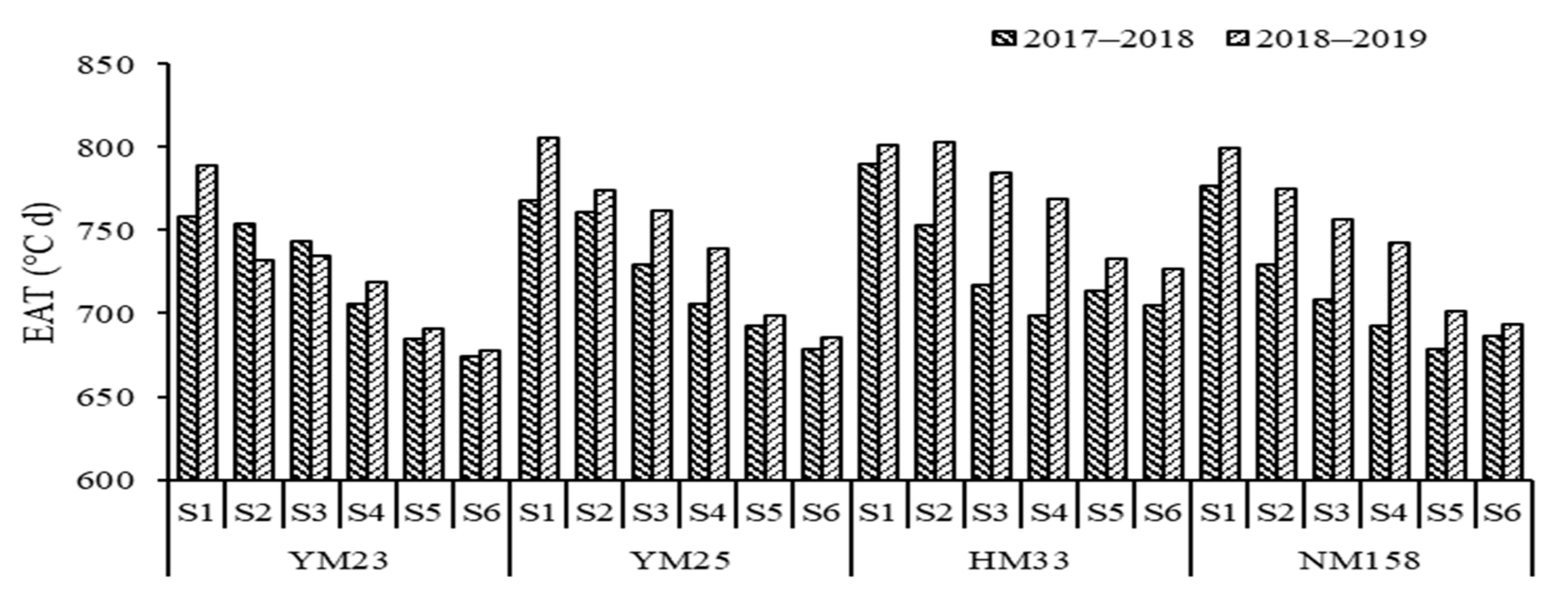


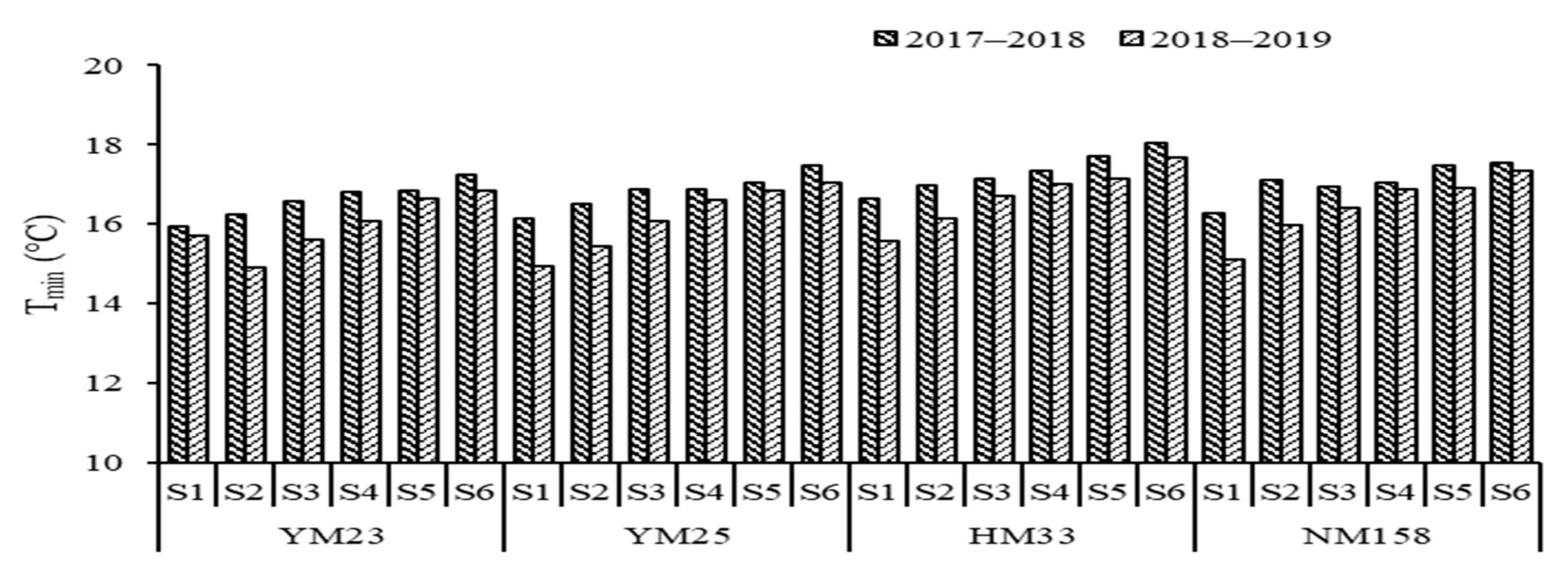
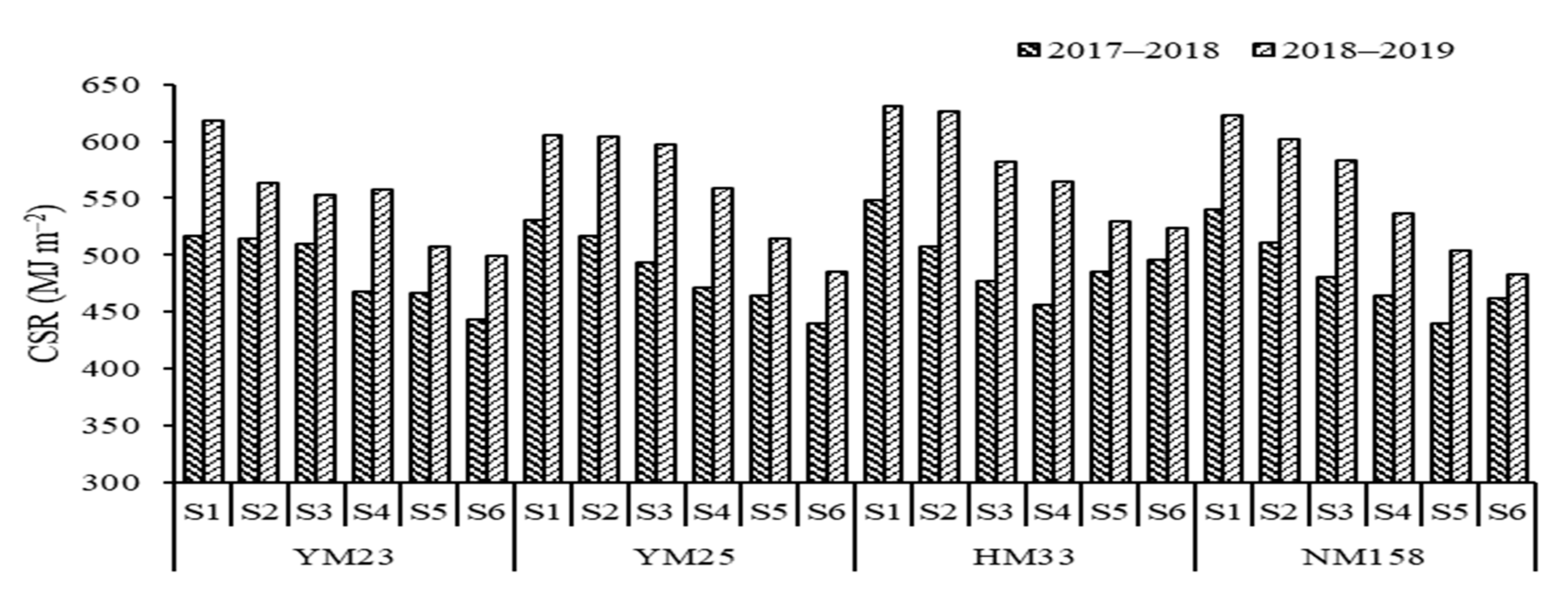
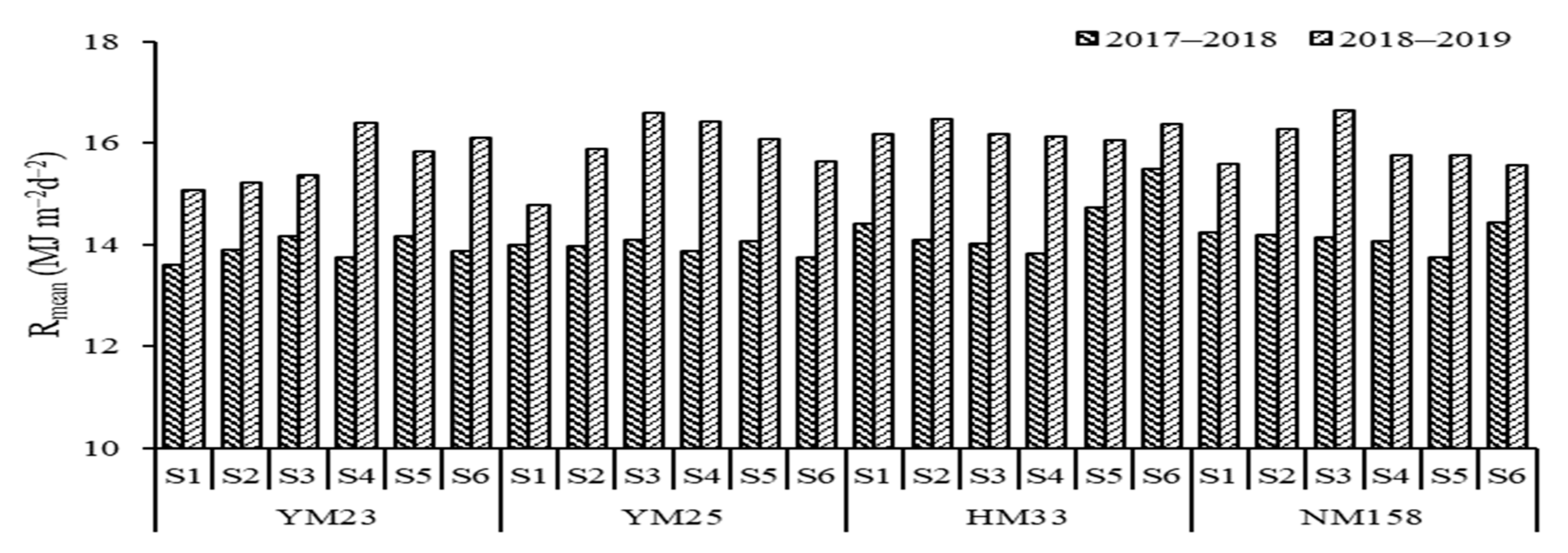
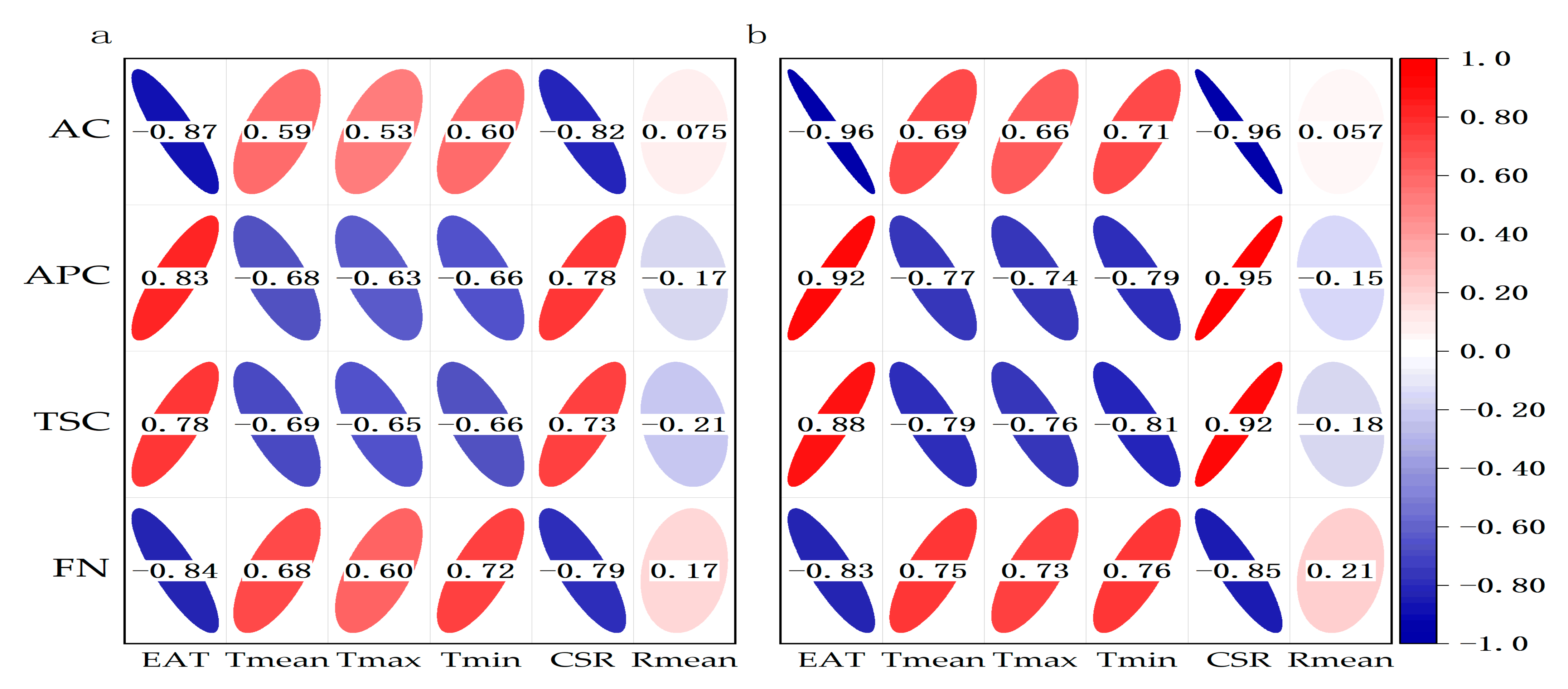
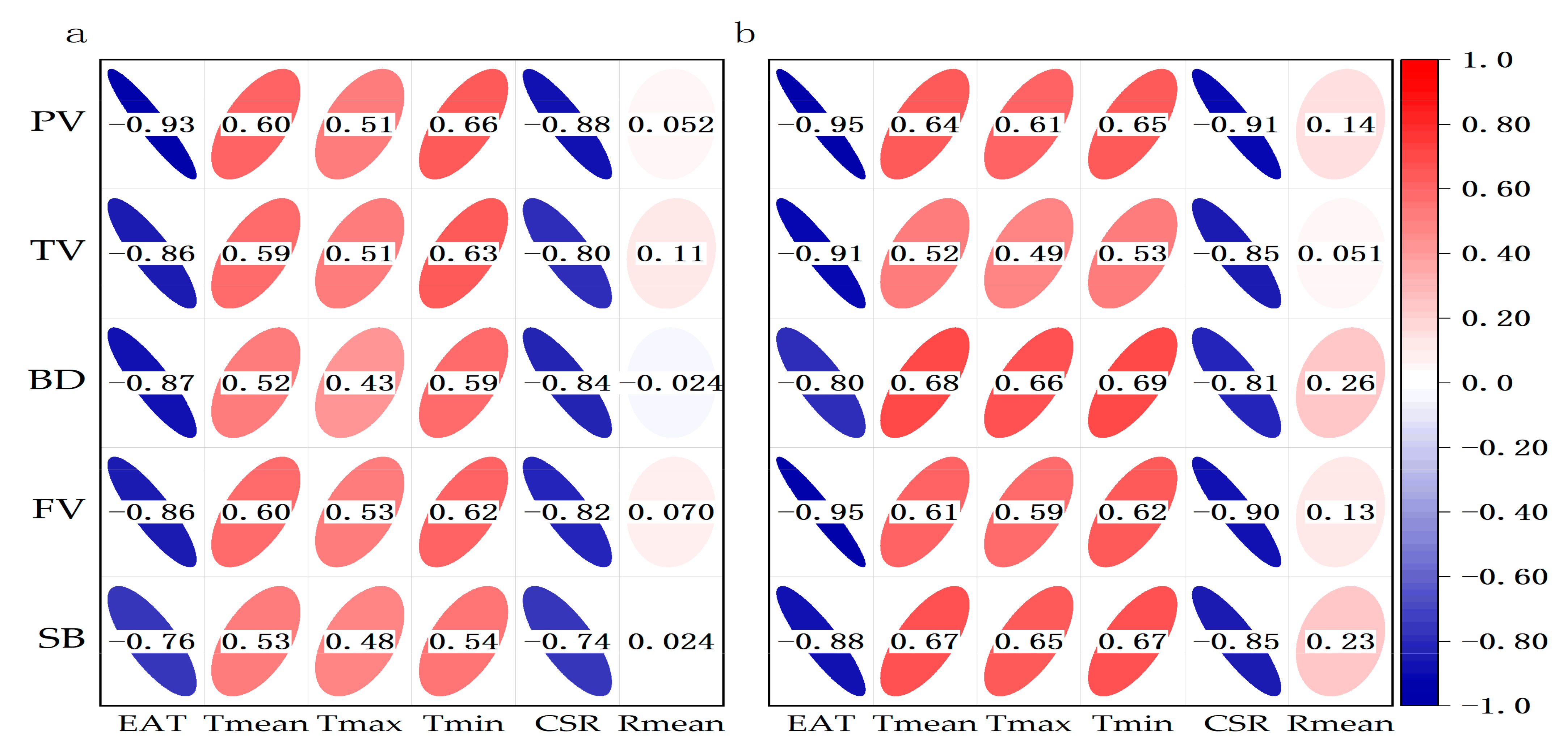
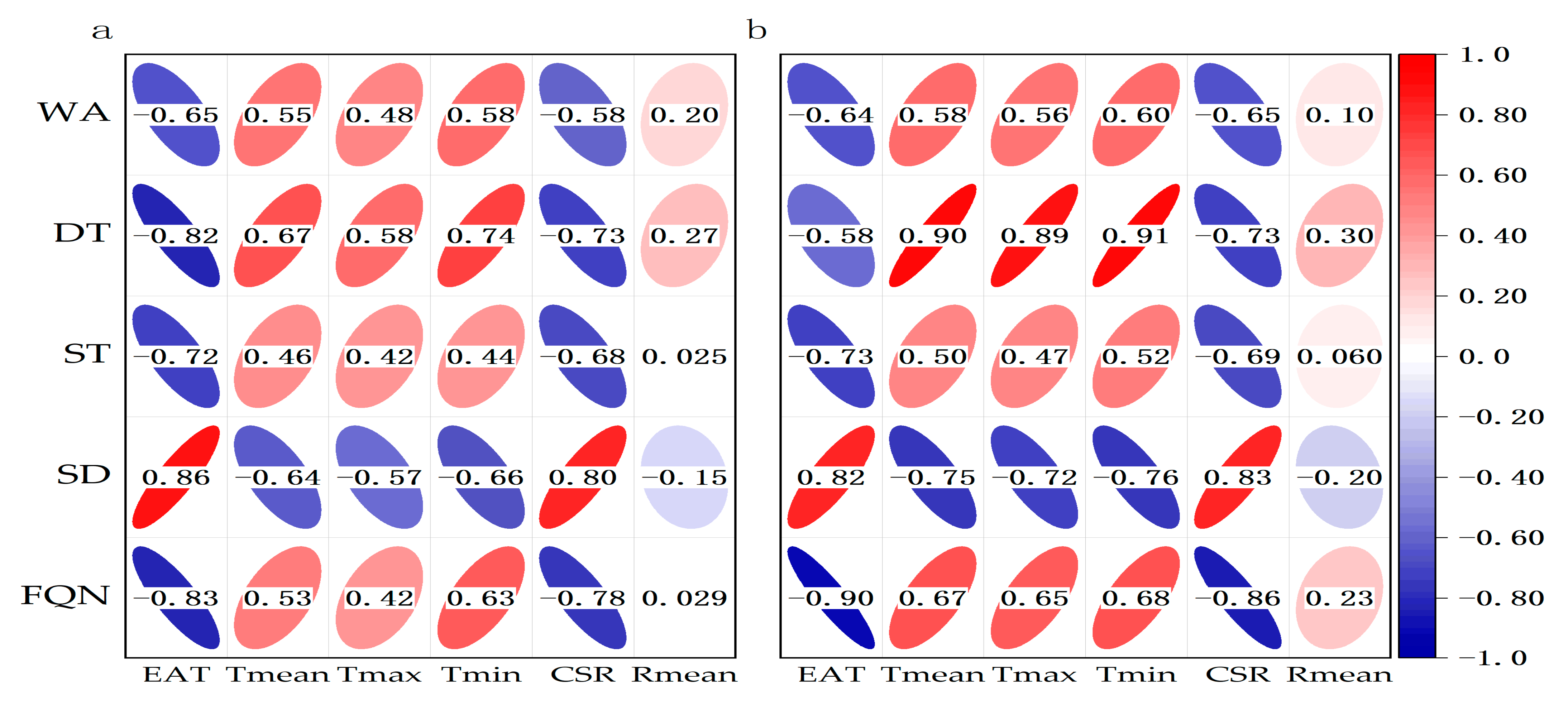
| Varieties | Treatment | 2017–2018 | 2018–2019 | ||||||
|---|---|---|---|---|---|---|---|---|---|
| AC (%) | APC (%) | TSC (%) | FN (s) | AC (%) | APC (%) | TSC (%) | FN (s) | ||
| YM23 | S1 | 13.85 e | 54.80 a | 68.64 a | 453.00 e | 13.56 d | 54.47 a | 68.03 a | 464.00 d |
| S2 | 14.27 de | 52.90 b | 67.17 b | 480.50 d | 14.33 c | 52.74 b | 67.07 b | 488.00 c | |
| S3 | 14.66 cd | 51.55 c | 66.21 c | 496.00 c | 14.78 bc | 50.01 c | 64.80 c | 500.50 bc | |
| S4 | 15.14 bc | 49.57 d | 64.71 d | 509.00 bc | 14.86 bc | 49.53 c | 64.39 c | 511.00 ab | |
| S5 | 15.45 ab | 47.75 e | 63.20 e | 513.50 ab | 15.26 ab | 47.70 d | 62.96 cd | 519.00 ab | |
| S6 | 15.63 a | 46.83 e | 62.46 e | 524.50 a | 15.61 a | 46.13 e | 61.74 d | 526.00 a | |
| YM25 | S1 | 13.01 d | 55.45 a | 68.46 a | 426.50 d | 13.11 e | 55.00 a | 68.11 a | 431.00 e |
| S2 | 13.40 cd | 53.90 b | 67.31 b | 452.00 c | 13.56 de | 53.46 ab | 67.02 ab | 458.50 d | |
| S3 | 13.95 c | 52.78 b | 66.72 b | 457.50 c | 13.98 cd | 52.76 b | 66.74 ab | 462.50 d | |
| S4 | 14.69 b | 51.10 c | 65.79 c | 460.50 c | 14.40 bc | 50.65 c | 65.04 bc | 475.00 c | |
| S5 | 15.45 a | 48.95 d | 64.40 d | 485.50 b | 15.13 ab | 48.47 d | 63.60 cd | 489.50 b | |
| S6 | 15.91 a | 47.97 d | 63.89 d | 509.50 a | 15.24 a | 46.17 e | 61.40 d | 509.50 a | |
| HM33 | S1 | 12.83 c | 56.58 a | 69.40 a | 445.00 e | 12.80 d | 55.72 a | 68.52 a | 456.00 d |
| S2 | 13.20 c | 54.58 b | 67.78 b | 461.00 d | 13.23 d | 53.33 b | 66.57 b | 467.00 d | |
| S3 | 13.70 b | 52.67 c | 66.38 bc | 485.50 c | 13.92 c | 51.47 c | 65.39 bc | 491.00 c | |
| S4 | 14.09 b | 51.65 c | 65.74 cd | 499.50 bc | 14.35 bc | 50.46 cd | 64.82 c | 505.50 b | |
| S5 | 14.91 a | 49.42 d | 64.34 d | 506.00 ab | 14.69 ab | 49.30 d | 63.98 cd | 510.50 ab | |
| S6 | 15.38 a | 47.20 e | 62.58 e | 515.50 a | 15.10 a | 47.85 e | 62.96 d | 520.50 a | |
| NM158 | S1 | 13.05 d | 57.45 a | 70.50 a | 440.50 e | 13.10 d | 56.22 a | 69.32 a | 456.50 d |
| S2 | 13.28 d | 56.10 b | 69.38 b | 469.00 d | 13.65 c | 54.64 a | 68.29 a | 476.50 cd | |
| S3 | 14.05 c | 54.95 b | 69.00 b | 480.00 cd | 13.94 c | 52.01 b | 65.94 b | 493.00 bc | |
| S4 | 14.80 b | 52.13 c | 66.93 c | 492.50 bc | 14.61 b | 50.23 c | 64.85 bc | 495.50 bc | |
| S5 | 15.34 ab | 50.15 d | 65.49 d | 506.50 ab | 15.16 a | 49.03 cd | 64.18 bc | 509.00 ab | |
| S6 | 15.68 a | 48.90 e | 64.57 e | 510.00 a | 15.44 a | 47.78 d | 63.22 c | 524.50 a | |
| Varieties | Treatment | 2017–2018 | 2018–2019 | ||||||||
|---|---|---|---|---|---|---|---|---|---|---|---|
| PV (cp) | TV (cp) | BD (cp) | FV (cp) | SB (cp) | PV (cp) | TV (cp) | BD (cp) | FV (cp) | SB (cp) | ||
| YM23 | S1 | 2785 e | 1802 d | 983 c | 3056 e | 1254 d | 2856 d | 1883 d | 972 e | 3101 e | 1218 d |
| S2 | 2885 d | 1885 c | 1000 c | 3222 d | 1338 c | 3024 c | 1981 cd | 1042 d | 3265 d | 1284 cd | |
| S3 | 3011 c | 1991 b | 1019 c | 3356 c | 1364 c | 3173 bc | 2089 bc | 1084 cd | 3416 c | 1327 bc | |
| S4 | 3143 b | 2063 a | 1080 b | 3461 b | 1398 b | 3240 ab | 2134 ab | 1107 bc | 3490 b | 1357 bc | |
| S5 | 3196 b | 2081 a | 1115 b | 3484 b | 1403 b | 3297 ab | 2145 ab | 1152 ab | 3536 b | 1391 ab | |
| S6 | 3287 a | 2122 a | 1165 a | 3583 a | 1461 a | 3392 a | 2220 a | 1172 a | 3659 a | 1439 a | |
| YM25 | S1 | 2702 e | 1725 e | 977 d | 2950 e | 1225 e | 2837 f | 1804 d | 1033 d | 3018 e | 1214 d |
| S2 | 2871 d | 1800 d | 1071 c | 3101 d | 1301 d | 2973 e | 1885 c | 1088 cd | 3158 d | 1274 cd | |
| S3 | 3020 c | 1903 c | 1117 bc | 3312 c | 1409 c | 3060 d | 1922 c | 1139 bc | 3278 c | 1357 bc | |
| S4 | 3093 bc | 1954 bc | 1139 abc | 3421 b | 1467 b | 3139 c | 1968 b | 1171 b | 3353 bc | 1385 b | |
| S5 | 3150 ab | 1988 ab | 1161 ab | 3460 b | 1472 ab | 3229 b | 2001 b | 1228 a | 3409 b | 1408 b | |
| S6 | 3242 a | 2037 a | 1205 a | 3557 a | 1521 a | 3310 a | 2052 a | 1258 a | 3575 a | 1523 a | |
| HM33 | S1 | 2699 e | 1788 d | 911 d | 2914 d | 1126 d | 2768 e | 1796 d | 972 d | 3010 e | 1214 e |
| S2 | 2741 e | 1813 d | 928 d | 3006 d | 1193 cd | 2867 d | 1841 d | 1026 c | 3099 d | 1258 d | |
| S3 | 2897 d | 1927 c | 971 c | 3218 c | 1291 bc | 2962 c | 1910 c | 1052 c | 3194 c | 1284 cd | |
| S4 | 3009 c | 1961 bc | 1049 b | 3328 bc | 1367 ab | 3069 b | 1959 b | 1110 b | 3265 b | 1306 bc | |
| S5 | 3079 b | 1985 b | 1094 a | 3398 ab | 1414 ab | 3130 b | 1996 ab | 1135 b | 3320 b | 1324 b | |
| S6 | 3137 a | 2030 a | 1108 a | 3477 a | 1447 a | 3217 a | 2027 a | 1191 a | 3400 a | 1373 a | |
| NM158 | S1 | 2740 e | 1853 d | 887 e | 2979 f | 1126 e | 2835 d | 1827 d | 1008 d | 3037 e | 1210 e |
| S2 | 2877 d | 1877 d | 1001 d | 3087 e | 1210 d | 2885 d | 1854 d | 1032 d | 3112 d | 1258 d | |
| S3 | 3039 c | 1938 c | 1101 c | 3171 d | 1234 d | 2982 c | 1921 c | 1062 c | 3207 c | 1286 cd | |
| S4 | 3099 b | 1957 bc | 1142 b | 3256 c | 1300 c | 3073 b | 1988 b | 1086 bc | 3305 b | 1317 bc | |
| S5 | 3140 a | 1979 ab | 1162 a | 3336 b | 1357 b | 3151 a | 2045 ab | 1106 ab | 3386 a | 1341 ab | |
| S6 | 3163 a | 1992 a | 1171 a | 3392 a | 1399 a | 3203 a | 2074 a | 1129 a | 3445 a | 1371 a | |
| Varieties | Treatment | 2017–2018 | 2018–2019 | ||||||||
|---|---|---|---|---|---|---|---|---|---|---|---|
| WA (%) | DT (min) | ST (min) | SD (FU) | FQN | WA (%) | DT (min) | ST (min) | SD (FU) | FQN | ||
| YM23 | S1 | 59.85 cd | 3.05 c | 7.50 d | 60.50 a | 69.00 d | 60.00 d | 3.00 c | 7.85 d | 58.50 a | 64.50 d |
| S2 | 59.05 d | 3.10 c | 7.70 d | 55.00 b | 70.00 d | 60.20 cd | 3.05 c | 8.10 cd | 59.00 a | 73.50 c | |
| S3 | 60.25 cd | 3.35 c | 8.15 c | 51.50 b | 77.50 cd | 61.15 bc | 3.40 b | 8.40 bc | 49.50 ab | 79.00 c | |
| S4 | 61.40 bc | 3.95 b | 8.60 b | 46.50 c | 84.00 bc | 61.45 bc | 3.50 b | 8.70 b | 45.00 bc | 86.50 b | |
| S5 | 62.75 ab | 4.30 b | 8.75 ab | 41.50 d | 91.50 b | 62.30 ab | 3.90 a | 9.25 a | 37.50 bc | 91.50 b | |
| S6 | 63.45 a | 4.70 a | 9.05 a | 39.00 d | 100.50 a | 62.80 a | 4.00 a | 9.50 a | 36.00 c | 98.50 a | |
| YM25 | S1 | 57.35 c | 2.80 e | 7.00 d | 66.50 a | 60.00 d | 53.60 e | 2.85 e | 6.60 d | 72.50 a | 55.50 d |
| S2 | 57.90 bc | 3.10 de | 7.15 cd | 66.00 a | 67.00 cd | 54.65 d | 3.15 de | 6.95 c | 66.50 ab | 64.00 cd | |
| S3 | 58.00 bc | 3.55 cd | 7.20 cd | 60.00 b | 68.50 cd | 56.05 c | 3.65 cd | 7.15 c | 63.50 b | 69.00 bc | |
| S4 | 58.35 b | 3.90 c | 7.35 bc | 57.50 bc | 73.50 bc | 57.05 b | 3.95 bc | 7.60 b | 53.00 c | 76.50 ab | |
| S5 | 59.95 a | 5.05 b | 7.57 ab | 54.50 cd | 79.00 b | 58.90 a | 4.60 ab | 7.95 a | 51.00 cd | 78.00 a | |
| S6 | 60.30 a | 5.75 a | 7.78 a | 50.50 d | 92.50 a | 59.50 a | 5.25 a | 7.85 ab | 44.00 d | 83.00 a | |
| HM33 | S1 | 60.20 c | 2.75 d | 6.95 e | 66.50 a | 71.00 d | 58.25 d | 3.55 d | 7.50 c | 60.50 a | 61.50 e |
| S2 | 60.65 b | 2.95 cd | 7.15 d | 66.00 a | 73.50 cd | 58.80 cd | 3.70 d | 7.45 c | 57.50 ab | 66.50 de | |
| S3 | 60.80 ab | 3.50 bc | 7.40 c | 60.00 b | 74.00 cd | 59.70 bc | 4.35 c | 7.75 bc | 54.50 ab | 73.00 cd | |
| S4 | 60.85 ab | 3.55 bc | 7.70 b | 57.50 bc | 76.50 bc | 61.00 ab | 4.65 bc | 8.15 ab | 49.00 bc | 75.00 bc | |
| S5 | 60.75 ab | 3.75 b | 8.00 a | 54.50 cd | 78.00 b | 61.75 a | 4.85 ab | 8.40 a | 43.50 c | 81.00 ab | |
| S6 | 61.70 a | 5.75 a | 8.10 a | 50.50 d | 82.50 a | 61.95 a | 5.10 a | 8.60 a | 41.50 c | 83.00 a | |
| NM158 | S1 | 59.55 e | 3.25 e | 6.50 d | 70.00 a | 67.50 e | 58.65 e | 3.05 d | 6.45 e | 73.00 a | 63.00 d |
| S2 | 59.95 de | 3.70 d | 6.88 cd | 62.00 b | 79.50 d | 59.55 d | 3.10 cd | 6.80 de | 63.00 b | 69.00 cd | |
| S3 | 60.75 cd | 4.05 c | 7.40 bc | 55.00 c | 89.00 c | 60.35 cd | 3.70 bc | 7.05 cd | 60.00 b | 74.00 bc | |
| S4 | 61.50 bc | 4.35 b | 7.95 ab | 49.50 cd | 95.00 bc | 60.70 bc | 3.85 b | 7.50 bc | 56.50 b | 75.50 bc | |
| S5 | 61.80 b | 4.55 a | 8.15 ab | 44.50 d | 100.50 ab | 61.45 ab | 4.25 b | 7.90 ab | 49.50 c | 81.50 ab | |
| S6 | 62.95 a | 4.70 a | 8.40 a | 43.50 d | 105.00 a | 61.75 a | 5.00 a | 8.30 a | 42.00 d | 83.50 a | |
Disclaimer/Publisher’s Note: The statements, opinions and data contained in all publications are solely those of the individual author(s) and contributor(s) and not of MDPI and/or the editor(s). MDPI and/or the editor(s) disclaim responsibility for any injury to people or property resulting from any ideas, methods, instructions or products referred to in the content. |
© 2023 by the authors. Licensee MDPI, Basel, Switzerland. This article is an open access article distributed under the terms and conditions of the Creative Commons Attribution (CC BY) license (https://creativecommons.org/licenses/by/4.0/).
Share and Cite
Zhang, Z.; Jia, D.; Wang, D.; Zhou, N.; Xing, Z.; Xu, K.; Wei, H.; Guo, B.; Zhang, H. Starch and Dough-Related Properties of Wheat (Triticum aestivum L.) Exposed to Varying Temperatures and Radiances after Anthesis. Agronomy 2023, 13, 1069. https://doi.org/10.3390/agronomy13041069
Zhang Z, Jia D, Wang D, Zhou N, Xing Z, Xu K, Wei H, Guo B, Zhang H. Starch and Dough-Related Properties of Wheat (Triticum aestivum L.) Exposed to Varying Temperatures and Radiances after Anthesis. Agronomy. 2023; 13(4):1069. https://doi.org/10.3390/agronomy13041069
Chicago/Turabian StyleZhang, Zhenzhen, Dinghan Jia, Dexin Wang, Nianbing Zhou, Zhipeng Xing, Ke Xu, Haiyan Wei, Baowei Guo, and Hongcheng Zhang. 2023. "Starch and Dough-Related Properties of Wheat (Triticum aestivum L.) Exposed to Varying Temperatures and Radiances after Anthesis" Agronomy 13, no. 4: 1069. https://doi.org/10.3390/agronomy13041069
APA StyleZhang, Z., Jia, D., Wang, D., Zhou, N., Xing, Z., Xu, K., Wei, H., Guo, B., & Zhang, H. (2023). Starch and Dough-Related Properties of Wheat (Triticum aestivum L.) Exposed to Varying Temperatures and Radiances after Anthesis. Agronomy, 13(4), 1069. https://doi.org/10.3390/agronomy13041069






